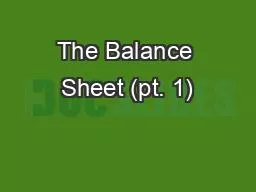/


Mr Leong Calculate the net worth of P Karkoulis Assets Liabilities Bank Account 185 Money Owed by Him 650 Electronic Equipment 1800 DVD Collection 225 Net Worth 4600 Motor Bike ID: 783514
Download The PPT/PDF document "The Balance Sheet (pt. 1)" is the property of its rightful owner. Permission is granted to download and print the materials on this web site for personal, non-commercial use only, and to display it on your personal computer provided you do not modify the materials and that you retain all copyright notices contained in the materials. By downloading content from our website, you accept the terms of this agreement.
Slide1
The Balance Sheet (pt. 1)Mr. Leong
Slide2Calculate the net worth of P. Karkoulis
Assets
Liabilities
Bank Account
$185
Money Owed by Him
$650
Electronic Equipment
$1,800
DVD Collection
$225
Net Worth
$4,600
Motor Bike
$1,200
Money Owed to Him
$100
Clothes
$1,000
Computer
$740
Assets
$5,250
Slide32. Fill in the missing amounts for each equation.
Assets
Liabilities
Net Worth
a)
$24,000
$14,000
$10,000
b)
$166,000
$56,000
$110,000
c)
$87,000
$47,000
$40,000
Slide4Creditors
These are people that you owe money too. By examining a balance sheet, they can see how much of a company’s money is owed to other people.
Slide52. Government
Corporations are required by law to include a balance sheet as part of the tax return.
Also, Statistics Canada is interested in certain data for reporting purposes.
Slide63. Investors
Investors want to see a balance sheet to know that their investments will not go bankrupt.
If a company does not have a lot of cash or has a lot of liabilities, it may not be a good investment.
Slide74. Owners
Owners can see how the financial position of a company is changing over time.
Owners need to ensure that their business has enough money to pay bills and stay in business.
Slide8Slide9Balance SheetA balance sheet summarizes information about
assets, liabilities, and owner’s equity
It provides a snapshot that shows how a business is doing on a given dayThe sheet is balanced because of the accounting formula
Slide10Rules of a Balance SheetStep 1: Fill in the Statement Heading; the balance sheet should answer the following questions:
Who?
What?WhenMark’s Repair ShopBalance SheetFebruary 16, 2018
Slide11Step 2: List the Assets:Assets are listed on the
LEFT HAND SIDE in order of liquidity (how easy it is to convert into cash)
Cash and accounts receivable are very liquid, whereas land and fixed assets are not
Slide12Step 3: List the Liabilities
Liabilities are listed in order of maturity date, that is the date to which the liability is due on the RIGHT HAND SIDE
Liabilities like accounts payable is due sooner than a bank loan, which is
Slide13Step 4: Calculate Owner’s Equity
There are $219,600 in assets, and $128,400 in liabilities. How much in owner’s equity is there?
$91,200
Slide14Step 5: Put it all Together
February 16, 2018
Slide15Try it yourself!Please do #19 on page 302
Slide16N. DroulisBalance Sheet
February 2, 2018
LiabilitiesAccounts Payable$12,000Salaries Payable
$16,500Taxes Payable$13,400Bank Loan
$43,000Mortgage Payable$111,000
Total Liabilities$195,900Owner’s Equity
N. Droulis, Equity$180,200
Total Liabilities and Owner’s Equity$376,100
Assets
Cash
$56,000
Accounts Receivable
$44,000
Supplies
$2,700
Merchandise Inventory
$34,500
Equipment
$78,900
Building and Land
$160,000
Total Assets
$376,100
Slide17Homework / Assignment due at the end of next class
Application #14 on page 301 (this will be worth
5 marks as an assignment), take your time and make it pretty and neat.If you finish early, you can play Lemonade Stand, review your notes / have some free time. On a lined piece of paper (or back of balance sheet), answer #14 with all errors of the balance sheet, total assets, and total liabilities and owner’s equity.